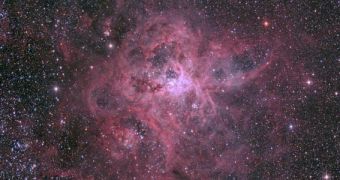In this new image from photographer Damian Peach, the Tarantula Nebula shines in all its splendor. The HII region, also known as NGC 2070 and 30 Doradus, lies in the Large Magellanic Cloud, one of the largest dwarf galaxies orbiting the Milky Way.
Until 1751, astronomers thought that the structure was in fact a single star. Sky watcher Nicolas Louis de Lacaille recognized that the object was in fact a nebula once telescope technology advanced enough.
The stellar nursery is one of the most complex and active in our galactic neighborhood, so it has received a lot of attention from astronomers over the centuries. Its spidery appearance is what eventually earned it its name of Tarantula Nebula.
At the core of the stellar nursery lies the NGC 2070 star cluster, as well as the remains of a relatively-new supernova. Due to the fact that the massive stars in the cluster are very young, they appear blue in this image. Tarantula Nebula is very likely to produce additional supernovae, as these behemoth stars will not live more than a few hundred million years.

 14 DAY TRIAL //
14 DAY TRIAL //